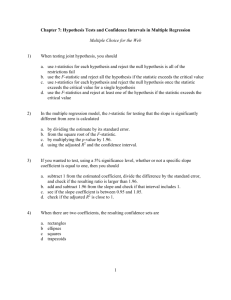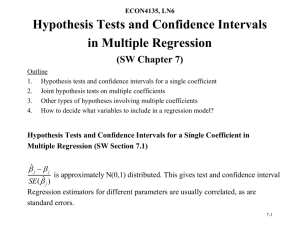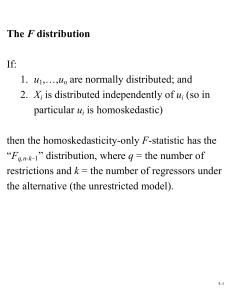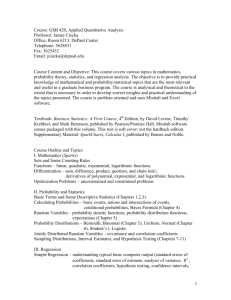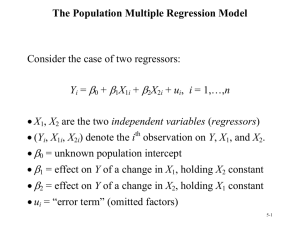Linear Regression Lecture Notes 4
advertisement
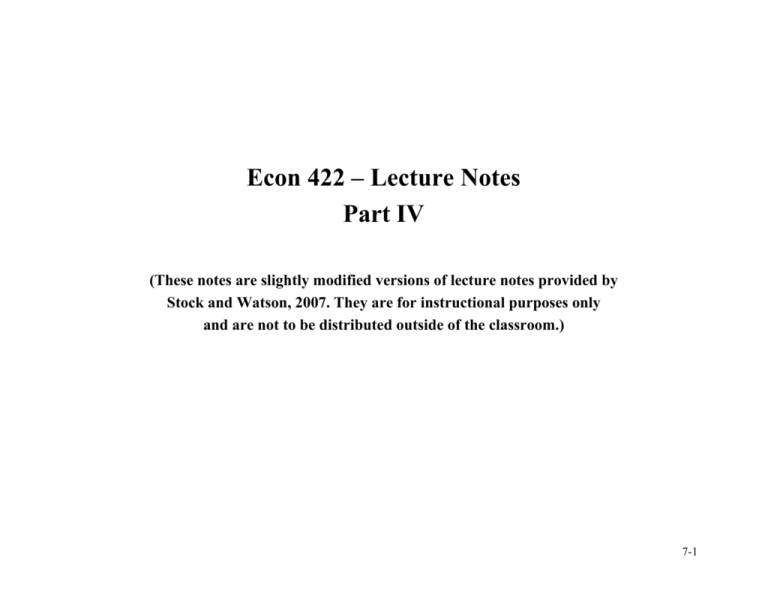
Econ 422 – Lecture Notes
Part IV
(These notes are slightly modified versions of lecture notes provided by
Stock and Watson, 2007. They are for instructional purposes only
and are not to be distributed outside of the classroom.)
7-1
Hypothesis Tests and Confidence Intervals
in Multiple Regression
Outline
1. Hypothesis tests and confidence intervals for a single
coefficient
2. Joint hypothesis tests on multiple coefficients
3. Other types of hypotheses involving multiple coefficients
4. How to decide what variables to include in a regression
model?
7-2
Hypothesis Tests and Confidence Intervals for a Single
Coefficient in Multiple Regression
•
βˆ1 − E ( βˆ1 )
is approximately distributed N(0,1) (CLT).
var( βˆ1 )
• Thus hypotheses on β1 can be tested using the usual tstatistic, and confidence intervals are constructed as { βˆ1 ±
1.96×SE( βˆ )}.
1
• So too for β2,…, βk.
• βˆ and βˆ are generally not independently distributed – so
1
2
neither are their t-statistics (more on this later).
7-3
Example: The California class size data
= 698.9 – 2.28×STR
TestScore
(1)
(10.4) (0.52)
(2)
= 686.0 – 1.10×STR – 0.650PctEL
TestScore
(8.7) (0.43)
(0.031)
• The coefficient on STR in (2) is the effect on TestScores of a
unit change in STR, holding constant the percentage of
English Learners in the district
• The coefficient on STR falls by one-half
• The 95% confidence interval for coefficient on STR in (2) is
{–1.10 ± 1.96×0.43} = (–1.95, –0.26)
• The t-statistic testing βSTR = 0 is t = –1.10/0.43 = –2.54, so
we reject the hypothesis at the 5% significance level
7-4
Standard errors in multiple regression in STATA
reg testscr str pctel, robust;
Regression with robust standard errors
Number of obs
F( 2,
417)
Prob > F
R-squared
Root MSE
=
=
=
=
=
420
223.82
0.0000
0.4264
14.464
-----------------------------------------------------------------------------|
Robust
testscr |
Coef.
Std. Err.
t
P>|t|
[95% Conf. Interval]
-------------+---------------------------------------------------------------str | -1.101296
.4328472
-2.54
0.011
-1.95213
-.2504616
pctel | -.6497768
.0310318
-20.94
0.000
-.710775
-.5887786
_cons |
686.0322
8.728224
78.60
0.000
668.8754
703.189
------------------------------------------------------------------------------
= 686.0 – 1.10×STR – 0.650PctEL
TestScore
(8.7) (0.43)
(0.031)
We use heteroskedasticity-robust standard errors – for exactly
the same reason as in the case of a single regressor.
7-5
Tests of Joint Hypotheses
Let Expn = expenditures per pupil and consider the
population regression model:
TestScorei = β0 + β1STRi + β2Expni + β3PctELi + ui
The null hypothesis that “school resources don’t matter,” and
the alternative that they do, corresponds to:
H0: β1 = 0 and β2 = 0
vs. H1: either β1 ≠ 0 or β2 ≠0 or both
TestScorei = β0 + β1STRi + β2Expni + β3PctELi + ui
7-6
Tests of joint hypotheses, ctd.
H0: β1 = 0 and β2 = 0
vs. H1: either β1 ≠ 0 or β2 ≠0 or both
• A joint hypothesis specifies a value for two or more
coefficients, that is, it imposes a restriction on two or more
coefficients.
• In general, a joint hypothesis will involve q restrictions. In
the example above, q = 2, and the two restrictions are β1 = 0
and β2 = 0.
• A “common sense” idea is to reject if either of the
individual t-statistics exceeds 1.96 in absolute value.
• But this “one at a time” test isn’t valid: the resulting test
rejects too often under the null hypothesis (more than 5%)!
7-7
Why can’t we just test the coefficients one at a time?
Because the rejection rate under the null isn’t 5%. We’ll
calculate the probability of incorrectly rejecting the null using
the “common sense” test based on the two individual tstatistics. To simplify the calculation, suppose that βˆ and βˆ
1
2
are independently distributed. Let t1 and t2 be the t-statistics:
βˆ1 − 0
βˆ2 − 0
t1 =
and t2 =
SE ( βˆ )
SE ( βˆ )
1
2
The “one at time” test is:
reject H0: β1 = β2 = 0 if |t1| > 1.96 and/or |t2| > 1.96
What is the probability that this “one at a time” test rejects
H0, when H0 is actually true? (We want it to be 5%.)
7-8
Suppose t1 and t2 are independent (for this calculation).
The probability of incorrectly rejecting the null hypothesis
using the “one at a time” test
= PrH 0 [|t1| > 1.96 and/or |t2| > 1.96]
= PrH 0 [|t1| > 1.96, |t2| > 1.96] + PrH 0 [|t1| > 1.96, |t2| ≤ 1.96]
+ PrH 0 [|t1| ≤ 1.96, |t2| > 1.96]
(disjoint events)
= PrH 0 [|t1| > 1.96] × PrH 0 [|t2| > 1.96]
+ PrH 0 [|t1| > 1.96] × PrH 0 [|t2| ≤ 1.96]
+ PrH 0 [|t1| ≤ 1.96] × PrH 0 [|t2| > 1.96]
(t1, t2 are independent by assumption)
= .05×.05 + .05×.95 + .95×.05
= .0975 = 9.75% – which is not the desired 5%!!
7-9
The size of a test is the actual rejection rate under the null
hypothesis.
• The size of the “common sense” test isn’t 5%!
• In fact, its size depends on the correlation between t1 and
t2 (and thus on the correlation between βˆ and βˆ ).
1
2
Two Solutions:
• Use a different critical value in this procedure – not 1.96
(this is the “Bonferroni method) (this method is rarely
used in practice however)
• Use a different test statistic that test both β1 and β2 at
once: the F-statistic (this is common practice)
7-10
The F-statistic
The F-statistic tests all parts of a joint hypothesis at once.
Formula for the special case of the joint hypothesis β1 = β1,0
and β2 = β2,0 in a regression with two regressors:
2
2
⎛
t
+
t
1 1 2 − 2 ρˆ t1 ,t2 t1t2 ⎞
F= ⎜
⎟⎟
2
⎜
2⎝
1 − ρˆ t1 ,t2
⎠
where ρˆ t1 ,t2 estimates the correlation between t1 and t2.
Reject when F is large (how large?)
7-11
The F-statistic testing β1 and β2:
2
2
⎛
t
+
t
1 1 2 − 2 ρˆ t1 ,t2 t1t2 ⎞
F= ⎜
⎟⎟
2
⎜
2⎝
1 − ρˆ t1 ,t2
⎠
• The F-statistic is large when t1 and/or t2 is large
• The F-statistic corrects (in just the right way) for the
correlation between t1 and t2.
• The formula for more than two β’s is nasty unless you use
matrix algebra.
• This gives the F-statistic a nice large-sample approximate
distribution, which is…
7-12
Large-sample distribution of the F-statistic
Consider special case that t1 and t2 are independent, so ρˆ t1 ,t2
p
→ 0; in large samples the formula becomes
2
2
⎛
t
+
t
1 1 2 − 2 ρˆ t1 ,t2 t1t2 ⎞ 1 2 2
F= ⎜
⎟⎟ ≈ (t1 + t2 )
2
⎜
2⎝
1 − ρˆ t1 ,t2
⎠ 2
• Under the null, t1 and t2 have standard normal distributions
that, in this special case, are independent
• The large-sample distribution of the F-statistic is the
distribution of the average of two independently
distributed squared standard normal random variables.
7-13
The chi-squared distribution with q degrees of freedom ( χ q2 )
is defined to be the distribution of the sum of q independent
squared standard normal random variables.
In large samples, F is distributed as χ q2 /q.
Selected large-sample critical values of χ q2 /q
q
1
2
3
4
5
5% critical value
3.84
(why?)
3.00
(the case q=2 above)
2.60
2.37
2.21
7-14
Computing the p-value using the F-statistic:
p-value = tail probability of the χ q2 /q distribution
beyond the F-statistic actually computed.
Implementation in STATA
Use the “test” command after the regression
Example: Test the joint hypothesis that the population
coefficients on STR and expenditures per pupil (expn_stu) are
both zero, against the alternative that at least one of the
population coefficients is nonzero.
7-15
F-test example, California class size data:
reg testscr str expn_stu pctel, r;
Regression with robust standard errors
Number of obs
F( 3,
416)
Prob > F
R-squared
Root MSE
=
=
=
=
=
420
147.20
0.0000
0.4366
14.353
-----------------------------------------------------------------------------|
Robust
testscr |
Coef.
Std. Err.
t
P>|t|
[95% Conf. Interval]
-------------+---------------------------------------------------------------str | -.2863992
.4820728
-0.59
0.553
-1.234001
.661203
expn_stu |
.0038679
.0015807
2.45
0.015
.0007607
.0069751
pctel | -.6560227
.0317844
-20.64
0.000
-.7185008
-.5935446
_cons |
649.5779
15.45834
42.02
0.000
619.1917
679.9641
-----------------------------------------------------------------------------NOTE
test str expn_stu;
( 1)
( 2)
The test command follows the regression
str = 0.0
expn_stu = 0.0
There are q=2 restrictions being tested
F( 2,
416) =
5.43
Prob > F =
0.0047
The 5% critical value for q=2 is 3.00
Stata computes the p-value for you
7-16
More on F-statistics: a simple F-statistic formula that is
easy to understand (it is only valid if the errors are
homoskedastic, but it might help intuition).
The homoskedasticity-only F-statistic
When the errors are homoskedastic, there is a simple formula
for computing the “homoskedasticity-only” F-statistic:
• Run two regressions, one under the null hypothesis (the
“restricted” regression) and one under the alternative
hypothesis (the “unrestricted” regression).
• Compare the fits of the regressions – the R2’s – if the
“unrestricted” model fits sufficiently better, reject the null
7-17
The “restricted” and “unrestricted” regressions
Example: are the coefficients on STR and Expn zero?
Unrestricted population regression (under H1):
TestScorei = β0 + β1STRi + β2Expni + β3PctELi + ui
Restricted population regression (that is, under H0):
TestScorei = β0 + β3PctELi + ui
(why?)
• The number of restrictions under H0 is q = 2 (why?).
• The fit will be better (R2 will be higher) in the unrestricted
regression (why?)
By how much must the R2 increase for the coefficients on
Expn and PctEL to be judged statistically significant?
7-18
Simple formula for the homoskedasticity-only F-statistic:
2
2
( Runrestricted
− Rrestricted
)/q
F=
2
(1 − Runrestricted
) /( n − kunrestricted − 1)
where:
2
Rrestricted
= the R2 for the restricted regression
2
Runrestricted
= the R2 for the unrestricted regression
q = the number of restrictions under the null
kunrestricted = the number of regressors in the
unrestricted regression.
• The bigger the difference between the restricted and
unrestricted R2’s – the greater the improvement in fit by
adding the variables in question – the larger is the
homoskedasticity-only F.
7-19
Example:
Restricted regression:
2
TestScore
= 644.7 –0.671PctEL, Rrestricted
= 0.4149
(1.0) (0.032)
Unrestricted regression:
TestScore
= 649.6 – 0.29STR + 3.87Expn – 0.656PctEL
(15.5) (0.48)
(1.59)
(0.032)
2
Runrestricted
= 0.4366, kunrestricted = 3, q = 2
so
2
2
( Runrestricted
− Rrestricted
)/q
F=
2
(1 − Runrestricted
) /( n − kunrestricted − 1)
(.4366 − .4149) / 2
=
= 8.01
(1 − .4366) /(420 − 3 − 1)
Note: Heteroskedasticity-robust F = 5.43…
7-20
The homoskedasticity-only F-statistic – summary
2
2
( Runrestricted
− Rrestricted
)/q
F=
2
(1 − Runrestricted
) /( n − kunrestricted − 1)
• The homoskedasticity-only F-statistic rejects when adding
the two variables increased the R2 by “enough” – that is,
when adding the two variables improves the fit of the
regression by “enough”
• If the errors are homoskedastic, then the
homoskedasticity-only F-statistic has a large-sample
distribution that is χ q2 /q.
• But if the errors are heteroskedastic, the large-sample
distribution is a mess and is not χ q2 /q
7-21
Digression: The F distribution
Your regression printouts might refer to the “F” distribution.
If the four multiple regression LS assumptions hold and:
5. ui is homoskedastic, that is, var(u|X1,…,Xk) does not
depend on X’s
6. u1,…,un are normally distributed
then the homoskedasticity-only F-statistic has the
“Fq,n-k–1” distribution, where q = the number of restrictions
and k = the number of regressors under the alternative (the
unrestricted model).
• The F distribution is to the χ q2 /q distribution what the
tn–1 distribution is to the N(0,1) distribution
7-22
The Fq,n–k–1 distribution:
• The F distribution is tabulated many places
• As n → ∞, the Fq,n-k–1 distribution asymptotes to the χ q2 /q
distribution:
The Fq,∞ and χ q2 /q distributions are the same.
• For q not too big and n≥100, the Fq,n–k–1 distribution and
the χ q2 /q distribution are essentially identical.
• Many regression packages (including STATA) compute
p-values of F-statistics using the F distribution
• You will encounter the F distribution in published
empirical work.
7-23
Another digression: A little history of statistics…
• The theory of the homoskedasticity-only F-statistic and
the Fq,n–k–1 distributions rests on implausibly strong
assumptions (are earnings normally distributed?)
• These statistics dates to the early 20th century… back in
the days when data sets were small and computers were
people…
• The F-statistic and Fq,n–k–1 distribution were major
breakthroughs: an easily computed formula; a single set of
tables that could be published once, then applied in many
settings; and a precise, mathematically elegant
justification.
7-24
A little history of statistics, ctd…
• The strong assumptions seemed a minor price for this
breakthrough.
• But with modern computers and large samples we can use
the heteroskedasticity-robust F-statistic and the Fq,¥
distribution, which only require the four least squares
assumptions (not assumptions #5 and #6)
• This historical legacy persists in modern software, in
which homoskedasticity-only standard errors (and Fstatistics) are the default, and in which p-values are
computed using the Fq,n–k–1 distribution.
7-25
Summary: the homoskedasticity-only F-statistic and the F
distribution
• These are justified only under very strong conditions –
stronger than are realistic in practice.
• Yet, they are widely used.
• You should use the heteroskedasticity-robust F-statistic,
with χ q2 /q (that is, Fq,∞) critical values.
• For n ≥ 100, the F-distribution essentially is the χ q2 /q
distribution.
• For small n, sometimes researchers use the F distribution
because it has larger critical values and in this sense is
more conservative.
7-26
Summary: testing joint hypotheses
• The “one at a time” approach of rejecting if either of the tstatistics exceeds 1.96 rejects more than 5% of the time
under the null (the size exceeds the desired significance
level)
• The heteroskedasticity-robust F-statistic is built in to
STATA (“test” command); this tests all q restrictions at
once.
• For n large, the F-statistic is distributed χ q2 /q (= Fq,∞)
• The homoskedasticity-only F-statistic is important
historically (and thus in practice), and can help intuition,
but isn’t valid when there is heteroskedasticity
7-27
Testing Single Restrictions on Multiple Coefficients
Yi = β0 + β1X1i + β2X2i + ui, i = 1,…,n
Consider the null and alternative hypothesis,
H0: β1 = β2 vs. H1: β1 ≠ β2
This null imposes a single restriction (q = 1) on multiple
coefficients – it is not a joint hypothesis with multiple
restrictions (compare with β1 = 0 and β2 = 0).
7-28
Testing single restrictions on multiple coefficients, ctd.
Here are two methods for testing single restrictions on
multiple coefficients:
1.
Rearrange (“transform”) the regression
Rearrange the regressors so that the restriction
becomes a restriction on a single coefficient in an
equivalent regression; or,
2.
Perform the test directly
Some software, including STATA, lets you test
restrictions using multiple coefficients directly
7-29
Method 1: Rearrange (“transform”) the regression
Yi = β0 + β1X1i + β2X2i + ui
H0: β1 = β2 vs. H1: β1 ≠ β2
Add and subtract β2X1i:
Yi = β0 + (β1 – β2) X1i + β2(X1i + X2i) + ui
or
Yi = β0 + γ1 X1i + β2Wi + ui
where
γ1 = β1 – β2
Wi = X1i + X2i
7-30
Rearrange the regression, ctd.
(a) Original system:
Yi = β0 + β1X1i + β2X2i + ui
H0: β1 = β2 vs. H1: β1 ≠ β2
(b) Rearranged (“transformed”) system:
Yi = β0 + γ1 X1i + β2Wi + ui
where γ1 = β1 – β2 and Wi = X1i + X2i
so
H0: γ1 = 0 vs. H1: γ1 ≠ 0
The testing problem is now a simple one:
test whether γ1 = 0 in specification (b).
7-31
Method 2: Perform the test directly
Yi = β0 + β1X1i + β2X2i + ui
H0 : β 1 = β 2
Example:
vs. H1: β1 ≠ β2
TestScorei = β0 + β1STRi + β2Expni + β3PctELi + ui
In STATA, to test β1 = β2 vs. β1 ≠ β2 (two-sided):
regress testscore str expn pctel, r
test str=expn
The details of implementing this method are softwarespecific.
7-32
Confidence Sets for Multiple Coefficients
Yi = β0 + β1X1i + β2X2i + … + βkXki + ui, i = 1,…,n
What is a joint confidence set for β1 and β2?
A 95% joint confidence set is:
• A set-valued function of the data that contains the true
parameter(s) in 95% of hypothetical repeated samples.
• The set of parameter values that cannot be rejected at the
5% significance level.
• You can find a 95% confidence set as the set of (β1, β2) that
cannot be rejected at the 5% level using an F-test (why not
just combine the two 95% confidence intervals?).
7-33
Joint confidence sets ctd.
Let F(β1,0,β2,0) be the (heteroskedasticity-robust) F-statistic
testing the hypothesis that β1 = β1,0 and β2 = β2,0:
95% confidence set = {β1,0, β2,0: F(β1,0, β2,0) < 3.00}
• 3.00 is the 5% critical value of the F2,∞ distribution
• This set has coverage rate 95% because the test on which
it is based (the test it “inverts”) has size of 5%
5% of the time, the test incorrectly rejects the null
when the null is true, so 95% of the time it does not;
therefore the confidence set constructed as the
nonrejected values contains the true value 95% of the
time (in 95% of all samples).
7-34
The confidence set based on the F-statistic is an ellipse
2
2
⎛
t
+
t
1 1 2 − 2 ρˆ t1 ,t2 t1t2 ⎞
≤ 3.00}
{β1, β2: F = ⎜
⎟
2
⎟
2 ⎝⎜
1 − ρˆ t1 ,t2
⎠
Now
1
2
2
ˆ
⎡
⎤
×
+
F=
t
t
1
2 − 2 ρ t1 ,t2 t1t2 ⎦
2
⎣
2(1 − ρˆ t1 ,t2 )
1
=
×
2
2(1 − ρˆ t1 ,t2 )
⎡ ⎛ βˆ − β ⎞ 2 ⎛ βˆ − β ⎞ 2
ˆ − β ⎞⎛ βˆ − β ⎞ ⎤
⎛
β
2,0
1
1,0
1
1,0
2
2,0
⎢⎜ 2
⎥
ˆ
+
+
ρ
2
⎟
⎜
⎟
⎟⎜
⎟
t1 ,t2 ⎜
⎜ SE ( βˆ ) ⎟⎜ SE ( βˆ ) ⎟ ⎥
⎢ ⎜⎝ SE ( βˆ2 ) ⎟⎠ ⎜⎝ SE ( βˆ1 ) ⎟⎠
1 ⎠⎝
2 ⎠
⎝
⎣
⎦
This is a quadratic form in β1,0 and β2,0 – thus the
boundary of the set F = 3.00 is an ellipse.
7-35
Confidence set based on inverting the F-statistic
7-36
An example of a multiple regression analysis – and how to
decide which variables to include in a regression…
A Closer Look at the Test Score Data
We want to get an unbiased estimate of the effect on test
scores of changing class size, holding constant student and
school characteristics (but not necessarily holding constant
the budget (why?)).
To do this we need to think about what variables to
include and what regressions to run – and we should do this
before we actually sit down at the computer. This entails
thinking beforehand about your model specification.
7-37
A general approach to variable selection and “model
specification”
• Specify a “base” or “benchmark” model.
• Specify a range of plausible alternative models, which
include additional candidate variables.
• Does a candidate variable change the coefficient of
interest (β1)?
• Is a candidate variable statistically significant?
• Use judgment, not a mechanical recipe…
• Don’t just try to maximize R2!
7-38
Digression about measures of fit…
It is easy to fall into the trap of maximizing the R2 and R 2
– but this loses sight of our real objective, an unbiased
estimator of the class size effect.
• A high R2 (or R 2 ) means that the regressors explain the
variation in Y.
• A high R2 (or R 2 ) does not mean that you have eliminated
omitted variable bias.
• A high R2 (or R 2 ) does not mean that you have an
unbiased estimator of a causal effect (β1).
• A high R2 (or R 2 ) does not mean that the included
variables are statistically significant – this must be
determined using hypotheses tests.
7-39
Back to the test score application:
• What variables would you want – ideally – to estimate the
effect on test scores of STR using school district data?
• Variables actually in the California class size data set:
o student-teacher ratio (STR)
o percent English learners in the district (PctEL)
o school expenditures per pupil
o name of the district (so we could look up average
rainfall, for example)
o percent eligible for subsidized/free lunch
o percent on public income assistance
o average district income
• Which of these variables would you want to include?
7-40
More California data…
7-41
Digression on presentation of regression results
• We have a number of regressions and we want to report
them. It is awkward and difficult to read regressions
written out in equation form, so instead it is conventional
to report them in a table.
• A table of regression results should include:
o estimated regression coefficients
o standard errors
o measures of fit
o number of observations
o relevant F-statistics, if any
o Any other pertinent information.
Find this information in the following table:
7-42
7-43
Summary: Multiple Regression
• Multiple regression allows you to estimate the effect on Y
of a change in X1, holding X2 constant.
• If you can measure a variable, you can avoid omitted
variable bias from that variable by including it.
• There is no simple recipe for deciding which variables
belong in a regression – you must exercise judgment.
• One approach is to specify a base model – relying on apriori reasoning – then explore the sensitivity of the key
estimate(s) in alternative specifications.
7-44
